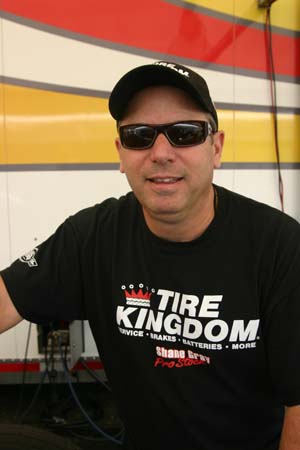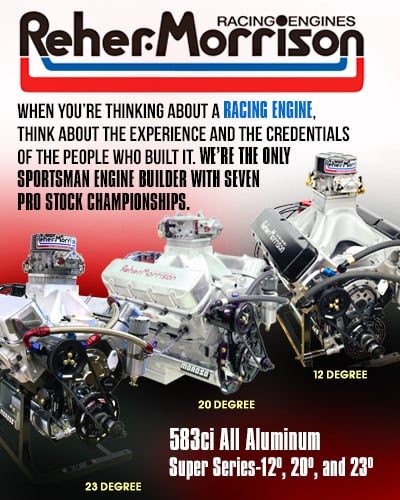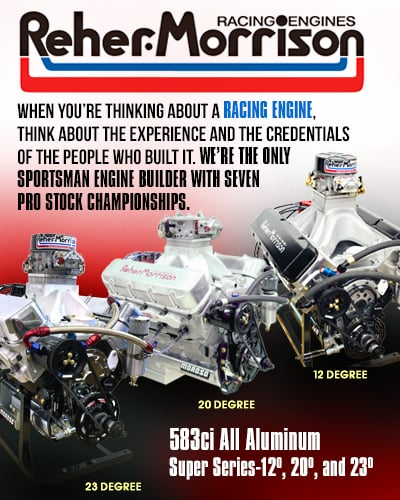YATES REINVENTS HIMSELF OUTSIDE OF THE COCKPIT
Yates, the two-time NHRA Pro Stock champion from Occoquan, Va., has reinvented himself all the while remaining in the class he’s raced for years. His newest assignment is to oversee the two-car team of Johnny Gray and when necessary implement the elements which made him a champion in the 1990s.
“I’m enjoying it right now,” admitted Yates, who considers himself neither a tuner nor a crew chief. “I’ve always been involved in the tuning of my cars and this is a little different. I think it’s the engineer in me, being a mechanical engineer I always enjoyed. Probably the biggest challenge I enjoyed the last five or six years of racing is trying to figure out how to make them run faster. I get enjoyment from this and I don’t have the stress of driving. Even when I enjoyed the driving, it’s part of the job that I could do without.”
 Jim Yates will be the first to admit, the view from the back of a race car isn’t so bad.
Jim Yates will be the first to admit, the view from the back of a race car isn’t so bad.
Yates, the two-time NHRA Pro Stock champion from Occoquan, Va., has reinvented himself all the while remaining in the class he’s raced for years. His newest assignment is to oversee the two-car team of Johnny Gray and when necessary implement the elements which made him a champion in the 1990s.
“I’m enjoying it right now,” admitted Yates, who considers himself neither a tuner nor a crew chief. “I’ve always been involved in the tuning of my cars and this is a little different. I think it’s the engineer in me, being a mechanical engineer I always enjoyed. Probably the biggest challenge I enjoyed the last five or six years of racing is trying to figure out how to make them run faster. I get enjoyment from this and I don’t have the stress of driving. Even when I enjoyed the driving, it’s part of the job that I could do without.”
In Yates' mind, being an overseer enables him to become more effective on a team with drivers at both ends of the experience spectrum.
“I think we’ve got one of the rookiest drivers in the class [in Shane] and one of the most experienced, Johnny in the other car,” explained Yates. “So it’s a good balance really when you look at it. Because Johnny gives us different feedback than Shane does, but Shane has done an excellent job.”
Shane stepped up from the Comp ranks this season and watching him progress and develop into a driver has been enjoyable for Yates to watch.
“He’s got a really good sense of knowing how far to drive the car, I give him that more than anything,” Yates said. “He has no intention of hurting that car, he knows exactly how far to go and when he comes back he can tell me where the car was at on the track and how loose it was. If he shut it off and why he shut it off and I urge him to continue to do that. He has a great situational awareness, I call it.”
The ability to bounce around from assignment to assignment within the Gray operation is a different situation than Yates experienced with his own Pro Stock operation. Yates admits he often left performance on the table by trying to do everything. Racers in today's Pro Stock class cannot afford to spread themselves so thin. In today's world one man can't do it all – at least not effectively.
“I think you give up [something] any time you do that and the sport has elevated,” Yates admitted. “Back in the day, back in the mid ‘90s you could do all of that. Warren did it; a lot of guys out here did that. But today you have to be very specialized. You have to have an engine builder, you have to have a clutch guy, and you have to a transmission guy. We’ve spread it out quite a bit, because as the sport escalates and gets faster and faster, every single aspect of that car has to do better. It’s not just the motor, not just the transmission, it’s the entire car. You have to work on it from bumper to bumper.
“In order to do that you need to spread it out over a group of people. Johnny Gray and James Gray’s team, (with what) they’ve put together here we have that opportunity, because we’ve got an awesome group of people. It’s not just me, it’s not just John [Yates' son], they’ve got [Craig] Hankinson here, they’ve got Mike Earl here, they’ve got a lot of people here to work on the car. It makes it a lot easier to do that. If you want to take the rear out they’ve got somebody to take the rear out. If you’re changing transmission ratios we’ve got a guy building transmission ratios. That all comes together; it allows you to do everything you need for the next run, not just the things you have time to do.”
Don’t get Yates wrong, there’s still a fire which burns inside to compete. However, with his role now, the fire can easily be quelched.
“I would still like to drive on Sunday; I always enjoyed the competition, one on one, me and somebody else in the other lane racing, that part,” said Yates. “I enjoyed that, it’s just the run after run after run; I enjoyed testing and I enjoyed eliminations. Qualifying I didn’t enjoy so much. I miss the competition, the getting up there lining up beside somebody that you know but you still want to kick their butt and you’re going to go out there and do your best. I miss that part a little bit but not enough to get back in the car and not be competitive.”
If the truth be known, Yates wonders if he shouldn’t have taken this route earlier than he did.
“My wife [Toni] always said after we won the second championship that we should have quit right then,” Yates said. “That’s what I wanted to do. You know it’s been a long time since that, and we’ve had a lot of good times. We’ve finished second twice, I think, or three times since then. Twice back in 2001, 2002. So we were still competitive but you just get to the point to where the sport has escalated to the point to where in order to be competitive you need to have more financial opportunities available to you. And it just wears you down after a while to where you don’t know if you can get it all done.”
But now, in his redefined drag racing role, Yates gets it done.




































